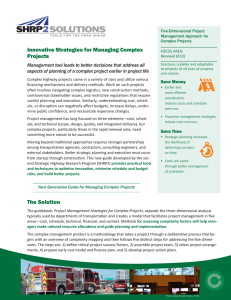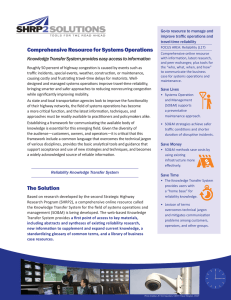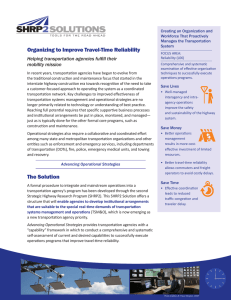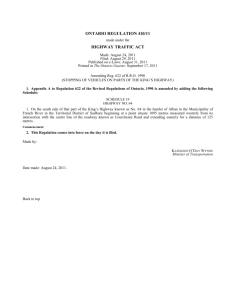Design Features to Reduce Nonrecurring Congestion
advertisement
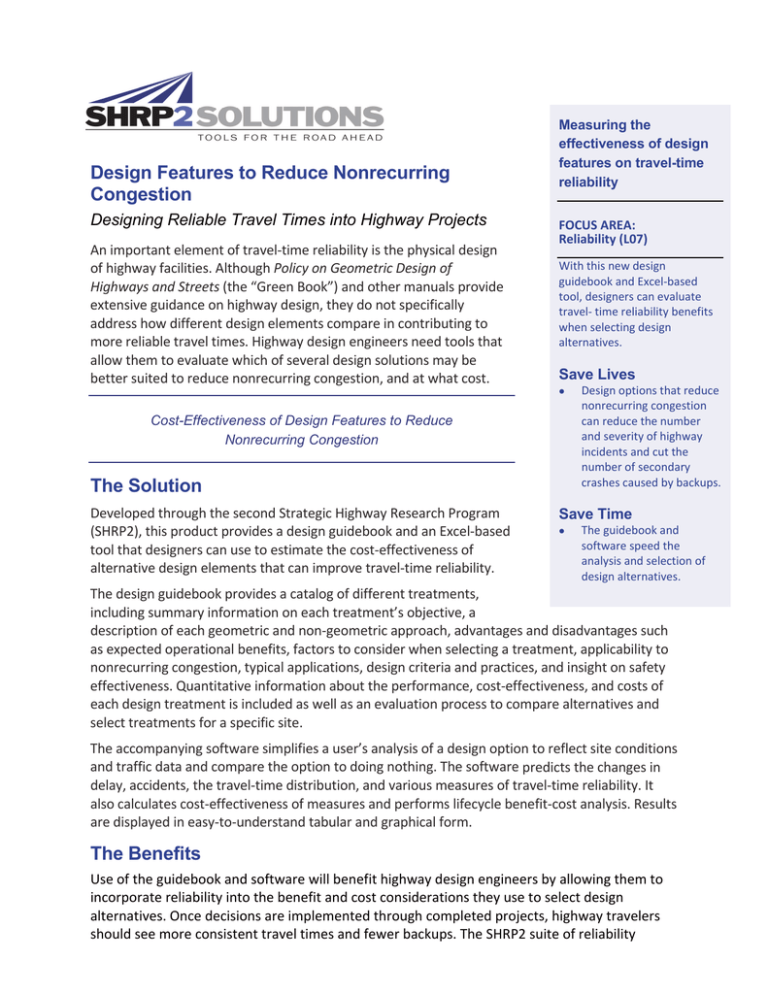
Design Features to Reduce Nonrecurring Congestion Designing Reliable Travel Times into Highway Projects An important element of travel‐time reliability is the physical design of highway facilities. Although Policy on Geometric Design of Highways and Streets (the “Green Book”) and other manuals provide extensive guidance on highway design, they do not specifically address how different design elements compare in contributing to more reliable travel times. Highway design engineers need tools that allow them to evaluate which of several design solutions may be better suited to reduce nonrecurring congestion, and at what cost. Measuring the effectiveness of design features on travel-time reliability FOCUS AREA: Reliability (L07) With this new design guidebook and Excel‐based tool, designers can evaluate travel‐ time reliability benefits when selecting design alternatives. Save Lives Cost-Effectiveness of Design Features to Reduce Nonrecurring Congestion The Solution Developed through the second Strategic Highway Research Program (SHRP2), this product provides a design guidebook and an Excel‐based tool that designers can use to estimate the cost‐effectiveness of alternative design elements that can improve travel‐time reliability. Design options that reduce nonrecurring congestion can reduce the number and severity of highway incidents and cut the number of secondary crashes caused by backups. Save Time The guidebook and software speed the analysis and selection of design alternatives. The design guidebook provides a catalog of different treatments, including summary information on each treatment’s objective, a description of each geometric and non‐geometric approach, advantages and disadvantages such as expected operational benefits, factors to consider when selecting a treatment, applicability to nonrecurring congestion, typical applications, design criteria and practices, and insight on safety effectiveness. Quantitative information about the performance, cost‐effectiveness, and costs of each design treatment is included as well as an evaluation process to compare alternatives and select treatments for a specific site. The accompanying software simplifies a user’s analysis of a design option to reflect site conditions and traffic data and compare the option to doing nothing. The software predicts the changes in delay, accidents, the travel‐time distribution, and various measures of travel‐time reliability. It also calculates cost‐effectiveness of measures and performs lifecycle benefit‐cost analysis. Results are displayed in easy‐to‐understand tabular and graphical form. The Benefits Use of the guidebook and software will benefit highway design engineers by allowing them to incorporate reliability into the benefit and cost considerations they use to select design alternatives. Once decisions are implemented through completed projects, highway travelers should see more consistent travel times and fewer backups. The SHRP2 suite of reliability products allows transportation agencies to integrate travel‐time reliability considerations into all major activities. These research products address how transportation agencies can be organized for reliability, how they can incorporate reliability into the planning process, and how they can measure and model reliability across their highway network. How can you learn more? This product is currently under development; summaries can be found at http://onlinepubs.trb.org/onlinepubs/shrp2/RFPL38/L07designguidesummary.pdf, http://onlinepubs.trb.org/onlinepubs/shrp2/RFPL38/L07toolsummary.pdf, and http://www.4ishgd.valencia.upv.es/index_archivos/80.pdf. For more information, contact Jawad Paracha at FHWA, jawad.paracha@dot.gov; Greta Smith at AASHTO, gsmith@aashto.org; Ralph Hessian at TRB, rhessian@nas.edu; or William Hyman at TRB, whyman@nas.edu. About SHRP2 Implementation The second Strategic Highway Research Program is a national partnership of key transportation organizations: the Federal Highway Administration, the American Association of State Highway and Transportation Officials, and the Transportation Research Board. Together, these partners conduct research and deploy products that will help the transportation community enhance the productivity, boost the efficiency, increase the safety, and improve the reliability of the Nation’s highway system. Strategic Highway Research Program U.S. Department of Transportation | Federal Highway Administration American Association of State Highway and Transportation Officials ● Transporta on Research Board

